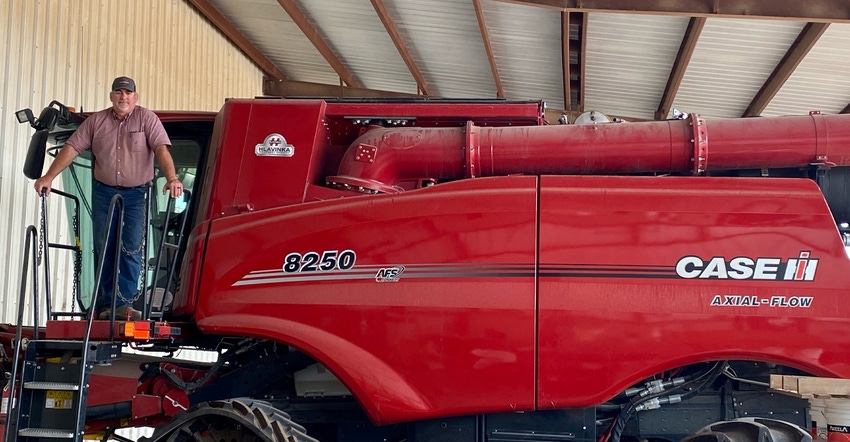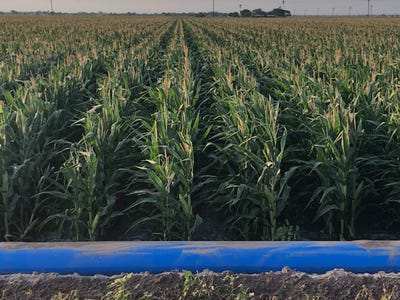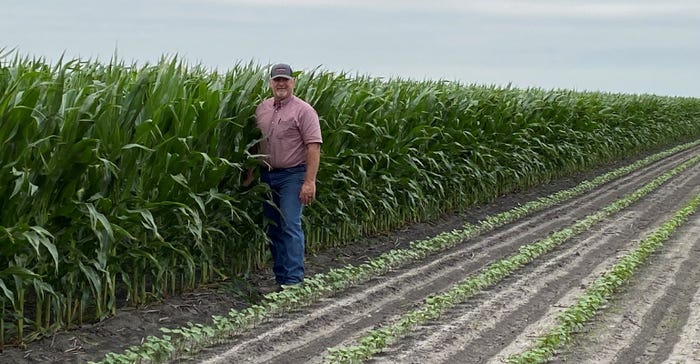
Recent South Texas rainfall, ranging from 2 to 10 inches, was "extremely welcome and beneficial," for many producers, says Jason Ott, Nueces County, Texas, AgriLife Extension agent.
Producer Scott Frazier described it as lifesaving.
"The east side of Nueces and San Patricio counties all had pretty significant rains, probably 6 inches to 8 or even as high as 10 inches in some spots," Frazier says. "As you get in the western parts of those counties, the further west you went, the less they got, maybe about 2 to 3 inches. Going south, closer to the coast, they did pretty good, but the further inland you go, the rain was more sparse.
"But it was a lifesaving rain for us."
 Irrigated corn planted February 25, near Edcouch, Texas. "Anything that's irrigated and we have water for looks good," says Brian Jones. (Photo by Brian Jones)
Irrigated corn planted February 25, near Edcouch, Texas. "Anything that's irrigated and we have water for looks good," says Brian Jones. (Photo by Brian Jones)
Frazier grows cotton, corn, and grain sorghum south of Corpus Christi near the Chapman Ranch area, with most of his land in the Driscoll, Bishop and Banquete regions and a small portion near Edroy.
"We were getting pretty desperate, needing a rain. It came a few days later than we prefer but certainly in time."
Before the May 1-rain event, Frazier says the moisture situation was serious. "A few fields were starting to show signs of wilt, but most of the eastern part of the county was holding on. The further west you go, the worse it is. You get into Jim Wells County and some of the very far western parts of the Nueces and San Patricio, they have some crops that will probably be lost or didn't get a good enough stand because they were too dry to begin with. But most of the area got a pretty decent crop started."
Frazier hopes the recent rainfall is enough to carry them for the next month. "It will probably be enough to finish most of the grain sorghum. The cotton will need at least one more rain -- a couple would be better, but one would be great."
Excessive but timely
Northeast of Nueces County, Brian Hlavinka, who farms 2,600 acres of corn in Wharton, Fort Bend and Brazoria Counties, says though the rainfall was excessive, it was timely.
"We had started irrigating some of our lighter ground about three days before that rain came, so it was timely, but on one of our farms, around East Bernard, we had between 6 and 8.5 inches. On another farm, 70 miles away, we had a 2-inch rain over three days, which was perfect.
"I don't normally complain about the rain too much. I'd rather have it than not and sometimes having it means you're going to have it in excess," he says.
Hlavinka produces corn, cotton, soybeans, and rice for Hlavinka Cattle Company, a family operation. "As far as our crop, we got a good start. The corn was a little bit later than normal. I have a target date of when I like to plant, and I was three or four days off that—we were pretty close. Cotton was just about right, and our beans went in timely."
See, Million-dollar rain or tough start in South Texas
This season, Hlavinka also planted 1,700 acres of rice. "For the first time ever, we had rice planted before April 1," he says.
 Brian Hlavinka says he is pleased with the progress of their 2021 crops. (Photos by Janie Hlavinka)
Brian Hlavinka says he is pleased with the progress of their 2021 crops. (Photos by Janie Hlavinka)
Small winter rains – .5 to .75 inches – got Hlavinka through planting season and the recent rainfall topped them off. "Small rains held us and helped us get a good start. I don't want it to be really wet. I prefer to be a little on the dry side early in the growth stage because those plants need to chase that moisture, you get a lot better root system. So, not so dry where it hurts your yield potential, but where your plants have to work for it."
Of his 1,250 cotton acres, Hlavinka says he's only had to replant one field, which isn't unusual. "I'll put it to you this way, I'm going to replant or at least touch up a field almost every year due to varying soil types. It's just that tough. So, it's not out of the ordinary."
Overall, he's pleased with their start.
Lower Rio Grande Valley
East of Hlavinka in the Lower Rio Grande Valley, Hidalgo Extension Agent Vidal Saenz says producers started this season dry and are still behind. "We're in a bad drought. Some people got rain, but it's not enough."
Some of the region's producers received the early May rainfall plus about 2 to 3 inches prior, allowing them to reduce irrigation applications. In the northwest part of the county, the dryland area, Saenz says the crops look good, even though it's hardly rained. "They probably got 2 inches of rain May 1st," he adds.
See, Corn prices cause ripple through economy
"The dryland crops are going to be below average on yield and the irrigated, they're pushing it hard. Producers are irrigating their crops, especially corn. It's tasseling, so it needs water. Even though they got an inch or two of rain, they're still going to fill the fields to get a good 6 inches on it."
Rio Grande producers irrigate from Falcon Lake, in adjacent Starr County. "The water comes in from the river into canals -- gravity fill. Some use pumps to get the water to where they need it but most of the farmers have a delivery point in each of the fields," Saenz says. " I think the lake is low."
Drought is evident in the region's pastures as well.
"We haven't gotten the grass back. It still seems like it's the dead of winter," Saenz says. "The cattle are thin, and everybody is feeding hay."
A year ago, a round bale cost $30 to $40. Today, Saenz says, they are about $80.
The drought is also forcing herd reduction. "When you start seeing young cows at the auction barn you know the drought is pretty bad," he adds.
Dry since October
Brain Jones, who farms corn, cotton, and grain sorghum in the Edcouch area, says it's been since last October since the Rio Grande Valley had much rain. "The dryland grain sorghum producers got it up and growing after the freeze and then caught a little bit of rain in places over the last two weeks," he says.
 Producer Brian Jones, Edcouch, Texas (Photo by Lisa Jones)
Producer Brian Jones, Edcouch, Texas (Photo by Lisa Jones)
Irrigated producers like Jones can water their crops but how much is determined by each of the irrigation districts. "We're either having to buy outside water and bring it in to carry a crop, or cutting back on acreage," he says.
Some are choosing not to irrigate. "I cut my acreage in half, so half is irrigated, and half is dryland. The dryland cotton was zeroed out two weeks after planting, so it's just open ground right now. I didn't have enough irrigation water and bought a little more to carry my corn and grain sorghum. We're looking at high prices and it seems to pencil out to be able to buy some outside water and carry those crops to term.
"Anything that's irrigated and we have water for looks good."
About the Author(s)
You May Also Like






